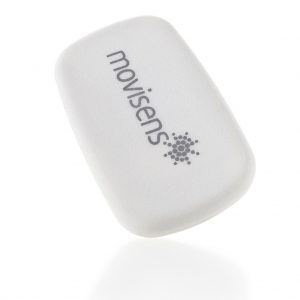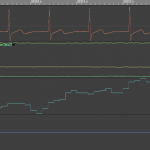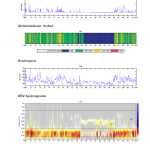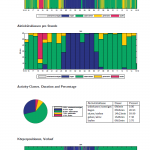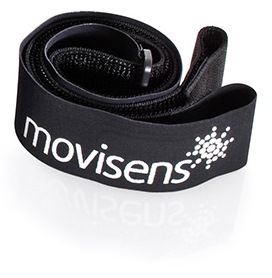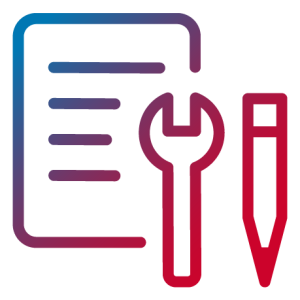ekgMove – ECG et Capteur d'Activité
movisens ekgMove est un système de mesure ambulatoire psycho-physiologique - optimisé pour des fins de recherche.
Le capteur enregistre les données brutes d'ECG, d'accélération tridimensionnelle, de pression barométrique de l'air et de température jusqu'à 2 semaines.
A partir de ces données, des paramètres comme le rythme cardiaque, la variabilité du rythme cardiaque, les pas, les taux d'activité et la dépense énergétique (Excel) peuvent être secondairement calculés à l'aide du logiciel DataAnalyzer, ainsi que des rapports significatifs (PDF).
Le capteur peut être fixé à l'aide soit d'une ventrale (disponible en taille XS, S, M ou L, sinon à la demande), soit d'électrodes adhésives.
Postulez gratuitement pour le projet d'étudiant
Principales caractéristiques
- Association d'un électrocardiogramme et d'un capteur d'activité physique dans un seul système
- Ventrale confortable avec un signal de haute qualité pour des mesures à long terme (jusqu'à 2 semaines), sans le câblage gênant des électrodes
- Un calcul exact et validé de la dépense énergétique et de la reconnaissance de l'activité
- Des données durables grâce au format de fichier ouvert
- Un fonctionnement optimisé pour les études
- Interfaces ouvertes : SDK pour Bluetooth et USB
Applications
- Mobile monitorage à long terme de l'ECG
- Mobile monitorage à long terme de la fréquence cardiaque et de la varibilité de la fréquence cardiaque
- Étude sur le système nerveux autonome
- Monitorage comportemental
- Monitorage du stress psycho-physiologique
- Calcul de la dépense énergétique et de la reconnaissance de l'activité
- Psycho-neuro-immunologie
- Informatique affective
- Integration dans de complexes systèmes de monitorage
Produits et services adaptés
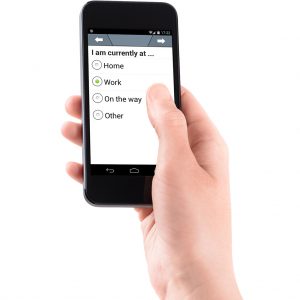
movisensXS
Echantillonnage de l'expérience plateforme
Solution d'échantillonnage de l'expérience basée sur un smartphone
Téléchargement
| Software |
|
|---|---|
| Documentation |
|
| Exemple de données |
|
| Exemple de rapports | |
| Outils externes |
Fiche technique
|
Power supply |
Lithium-Ion battery |
|
Supply voltage |
3 V |
|
Battery voltage |
2,7 - 4,2 V |
|
Number of charging cycles |
300 with 1C/1C > 80% |
|
Maximum recording capacity |
At least 2 weeks, depending on firmware configuration |
|
Battery run time (recording, Bluetooth off) |
~ 2 days |
|
Size of sensor (W x H x D) |
62,3mm x 38,6mm x 10,5mm |
|
Weight of sensor |
23,2g |
|
Internal sensors |
ECG-Amplifier: Resolution: 12bit, Input range CM=560mV, DM=+/-5mV, Gain 227, 3db bandwidth 1,6 to 33Hz Output rate: 256Hz to 1024Hz
3D acceleration sensor: Measurement range: +/- 8 g Noise: 4 mg Output rate: 64 Hz
Pressure sensor: Measurement range: 300 - 1100 hPa Noise: 0,03 hPa Output rate: 1 Hz |
|
Indicators |
LED, 3-color (operation and charging status) Vibrating alert (start and end of measurement) |
|
Interfaces |
Micro-USB, Bluetooth |
|
Environmental conditions |
Temperature: -20 °C to 60 °C 0 °C to 45 °C during charging
Humidity: 0 to 75% RH relative humidity
Atmospheric pressure: 300 to 1100 hPa absolute |
Littérature et validations
- Effect of Workstation Type on the Relationship Between Fatigue, Physical Activity, Stress, and Sleep.
- Heart rate variability change during a stressful cognitive task in individuals with anxiety and control participants.
- Effect of Spatial Disorientation in a Virtual Environment on Gait and Vital Features in Patients with Dementia: Pilot Single-Blind Randomized Control Trial.
- The CARP Mobile Sensing Framework -- A Cross-platform, Reactive, Programming Framework and Runtime Environment for Digital Phenotyping..
- From ear to eye? No effect of transcutaneous vagus nerve stimulation on human pupil dilation: A report of three studies.
- Heartbeats in the Wild: A Field Study Exploring ECG Biometrics in Everyday Life.
- Tele-Monitoring of Cancer Patients’ Rhythms during Daily Life Identifies Actionable Determinants of Circadian and Sleep Disruption..
- Social anxiety is associated with heart rate but not gaze behavior in a real social interaction..
- Stress-buffering effects of physical activity and cardiorespiratory fitness on metabolic syndrome: A prospective study in police officers..
- Does Cardiorespiratory Fitness Buffer Stress Reactivity and Stress Recovery in Police Officers? A Real-Life Study..
- Teachers’ ambulatory heart rate variability as an outcome and moderating variable in the job demands-resources model..
- I know how you feel - Predicting emotions from sensors for assisted pedelec experiences in smart cities.
- Ambulatory Assessment of Psychological and Physiological Stress on Workdays and Free Days Among Teachers. A Preliminary Study..
- Driver Stress Response to Self-driving Vehicles and Takeover Request -- An Expert Assessment.
- Arousal Measurement Reflected in the Pupil Diameter for a Decision-Making Performance in Serious Games.
- What could the baseline measurements predict about decision-making performance in serious games set in the financial context.
- Effects of Biophilic Interventions in Office on Stress Reaction and Cognitive Function: A Randomized Crossover Study in Virtual Reality.
- Sedentary behavior in everyday life relates negatively to mood: An Ambulatory Assessment study.
- Heart Rate Variability and Performance of Commercial Airline Pilots during Flight Simulations.
- Self-reported emotion regulation difficulties are associated with mood but not with the biological stress response to thin ideal exposure.
- Cockpit Pilot Warning System: A Preliminary Study.
- A Pilot Mental Workload Case Study in a Full Flight Simulator.
- Energy Expenditure During Incline Walking – Benefits of Integrating a Barometer into Activity Monitors.
- Paranoid Delusions as an Adaptive Response to Social Evaluative Stress?.
- Effectiveness of a smartphone-based worry-reduction training for stress reduction: A randomized-controlled trial.
- Brute Force ECG Feature Extraction Applied on Discomfort Detection.
- An experience sampling study on the nature of the interaction between traumatic experiences, negative affect in everyday life, and threat beliefs.
- Effects of office workstation type on physical activity and stress.
- Immediate and sustained effects of intermittent exercise on inhibitory control and task-related heart rate variability in adolescents.
- Physiological and cognitive performance of exposure to biophilic indoor environment.
- A Data Compression Hardware Accelerator Enabling Long-Term Biosignal Monitoring Based on Ultra-Low Power IoT Platforms.
- Sport activities in daily routine.
- Physical Activity and Affective Well-Being in Everyday Life Comparing Sport Activities and Daily Physical Activities Regarding Acute and Sustainable Associations.
- Resource Efficient Data Compression Algorithms for Demanding, WSN based Biomedical Applications.
- Mobile Sensors for Multiparametric Monitoring in Epileptic Patients.
- Real-Time Management of Multimodal Streaming Data for Monitoring of Epileptic Patients.
- Does a 20-week aerobic exercise training programme increase our capabilities to buffer real-life stressors? A randomized, controlled trial using ambulatory assessment.
- Integrating biosignals into information systems: A NeuroIS tool for improving emotion regulation.
- A personalized and reconfigurable cyberphysical system to handle multi-parametric data acquisition and analysis for mobile monitoring of epileptic patients.
- Study protocol: psychological and physiological consequences of exposure to mass media in young women-an experimental cross-sectional and longitudinal study and the role of moderators.
- Comparing Objective and Subjective Methods to Support Reflective Learning: an Experiment on the Influence on Affective Aspects.
- Emotions and Emotion Regulation in Economic Decision Making.
- Design and Evaluation of Affective Serious Games for Emotion Regulation Training.
- Komfortgewinn für Passagiere auf Langstreckenflügen durch den Einsatz chronobiologisch angepasster LED-Kabinenbeleuchtung.
- A Biofeedback Game for Training Arousal Regulation during a Stressful Task: The Space Investor.
- Measuring emotional arousal for online applications: Evaluation of ultra-short term heart rate variability measures.
- Enhancing mobile working memory training by using affective feedback..
- Mobile sensor systems for measurement of stress and physical activity in preventive healthcare applications.
- A Serious Game using Physiological Interfaces for Emotion regulation Training in the Context of Financial Decision-Making..
- An approach to automotive ECG measurement validation using a car-integrated test framework.
- Motivation and User Acceptance of Using Physiological Data to Support Individual Reflection.
- Estimation of energy expenditure using accelerometers and activity-based energy models - validation of a new device.
- User Study: Motivation and User Acceptance of Using Physiological Data to Support Individual Reflection..
- From Stress Awareness to Coping Strategies of Medical Staff: Supporting Reflection on Physiological Data.
- Einsatz sensorgestützter Verfahren im Gesundheitswesen: Herausforderungen und Lösungsansätze.
- Sensor Chest Strap Wirelessly Coupled with an e-Diary for Ambulatory Assessment of Psycho-Physiological Data.
- Heart rate variability: standards of measurement, physiological interpretation and clinical use. Task Force of the European Society of Cardiology and the North American Society of Pacing and Electrophysiology..
Vous trouverez plus de publications ici.
